foodndrink.org
Utilising human-review and AI, the most deep-diving website review service for food and drink-related businesses
★ Get your own unique FAQ + Selling Points on your profile page
★ be seen by 1000s of daily visitors and win new business
foodndrink.org Ephemeral Miniblog
The Tricks of the Trade
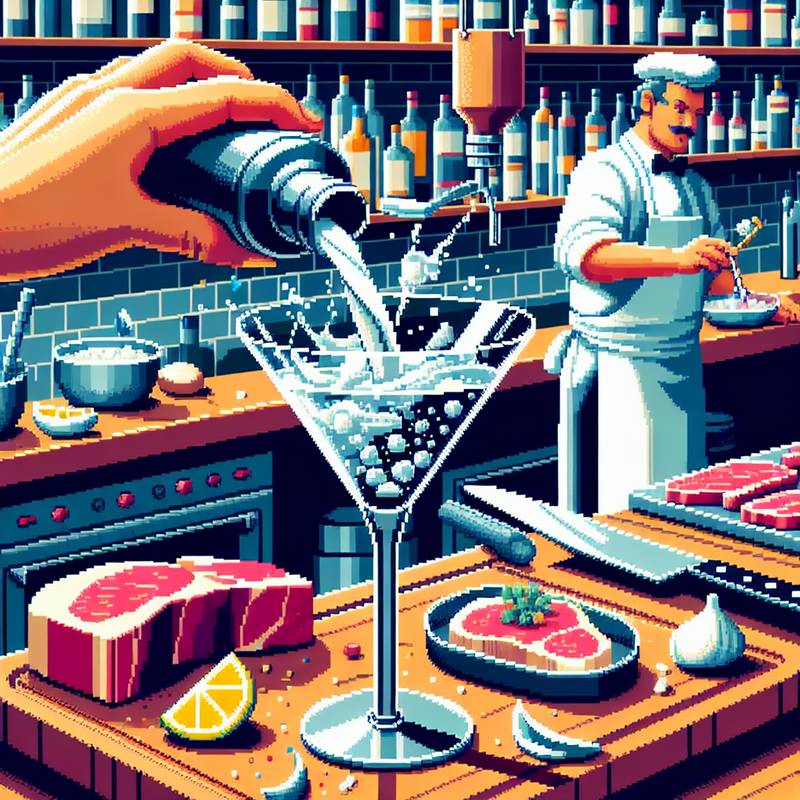 The trick behind the bar is remembering you’ve got to look like you know what you’re doing – even if your cocktail shaker’s got a cracked lid and your lemon garnish looks like it's been cut with a trowel. One lad I trained with used to swill Martini glasses with vermouth, swirl it like he was auditioning for the Bolshoi Ballet, then tip it out before adding the gin. Said it was 'seasoning' the glass. I said, “You’re wasting good booze,” but he swore that faint trace of vermouth made the gin taste smoother. I tried it once – might as well’ve drunk the label off the bottle.
The trick behind the bar is remembering you’ve got to look like you know what you’re doing – even if your cocktail shaker’s got a cracked lid and your lemon garnish looks like it's been cut with a trowel. One lad I trained with used to swill Martini glasses with vermouth, swirl it like he was auditioning for the Bolshoi Ballet, then tip it out before adding the gin. Said it was 'seasoning' the glass. I said, “You’re wasting good booze,” but he swore that faint trace of vermouth made the gin taste smoother. I tried it once – might as well’ve drunk the label off the bottle.Meanwhile, behind the stove, a chef I knew used to rest steaks on top of sliced onions – not for flavour, but because he said the onions soaked up the juices and stopped the meat stewing on the board. Clever, really. You got a better steak and a head start on your gravy. That’s the magic – not the fancy gadgets, but the stuff they don’t put in the cookbook.
Loading...
Swap Your Sprout, Embrace the Chard!
 Swap Your Sprout, Embrace the Chard!
Swap Your Sprout, Embrace the Chard! Picture this: it’s the cusp of spring. The sheds are sweating, daffodils are doing jazz hands, and your winter veg is suddenly less glamorous than a tepid vol-au-vent. Time to usher in some seasonal sparkle.
Cabbage feeling a bit too Dickensian? Try swiss chard. Gleaming, rainbow-stemmed chard brings both va-va-voom and vitamin K to the plate — a glitzy stand-in for your colder-weather brassicas. Steam it lightly, sauté with a whisper of garlic, or roll it round a filling like a leaf-based papoose.
If you were planning a stew with kale, but it’s gone on gardening leave, chard slides in with the grace of a spoonful of custard down a banister. Even your nan will nod in approval — it’s versatile, available, and tastes like spring putting on trousers.
Grab it early, before it gets as scarce as a polite goose in July.
Loading...
From Bland to Brilliant
 A plate of plain pasta sat there like a tired gumshoe at the end of a long night—functional, but barely holding itself together. You could dress it up with sauce from a jar and call it dinner, but that’s like slapping lipstick on a suspect and hoping they can sing.
A plate of plain pasta sat there like a tired gumshoe at the end of a long night—functional, but barely holding itself together. You could dress it up with sauce from a jar and call it dinner, but that’s like slapping lipstick on a suspect and hoping they can sing.Pour a little browned butter into the mix, dark and nutty like a jazz tune in a smoke-filled bar. Then shave in fresh lemon zest—just enough to cut through the richness like a dame’s laugh slicing through a room full of hard luck.
That’s the thing about a good meal. It doesn’t shout; it whispers. One subtle twist, maybe two, and the whole thing hums with intent. Add toasted pine nuts or a crumble of sharp cheese if you’re feeling dangerous. But know when to put the blackjack down. Too much, and you’ve lost the plot.
Keep it simple. Keep it sharp. And always let the flavors do the talking—less confession, more cross-examination.
Loading...
Roasting Is a Lie
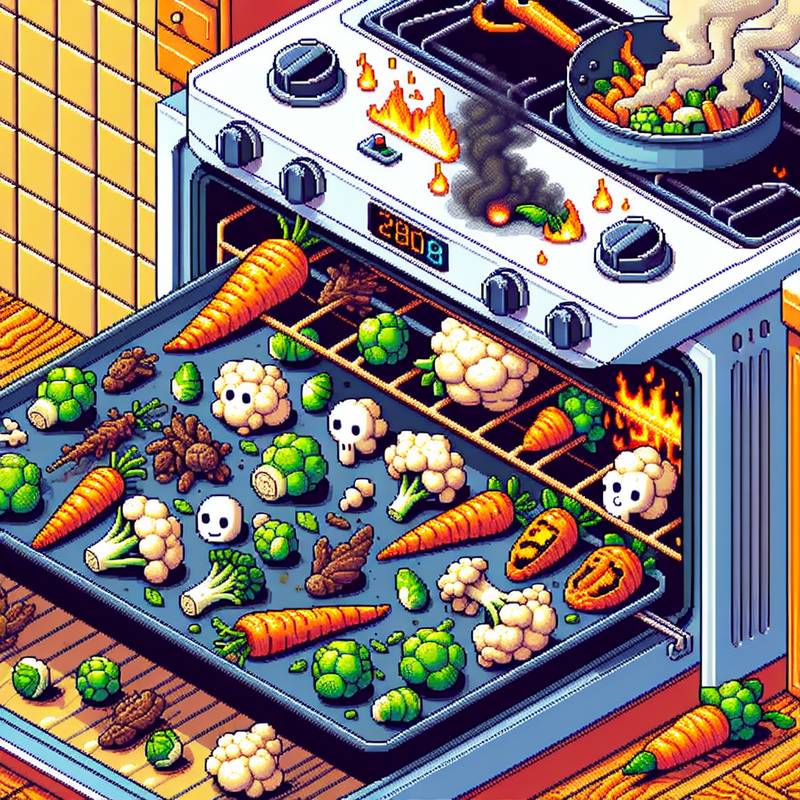 The thing no one ever admits about roasting vegetables is that it’s actually just a fancy-sounding way to dry them out and scorch the edges of your baking sheet beyond recognition. Everyone’s like, “Roast them! It’s easy! Just olive oil, salt, 400 degrees for 30 minutes,” and then boom: you’ve got a tray of shriveled root corpses masquerading as dinner, plus a smoke detector that may never trust you again.
The thing no one ever admits about roasting vegetables is that it’s actually just a fancy-sounding way to dry them out and scorch the edges of your baking sheet beyond recognition. Everyone’s like, “Roast them! It’s easy! Just olive oil, salt, 400 degrees for 30 minutes,” and then boom: you’ve got a tray of shriveled root corpses masquerading as dinner, plus a smoke detector that may never trust you again.Here’s the truth: roasting is not foolproof. It is a high-stakes game where seconds matter and oven hot spots will expose your weaknesses. Carrots go from “firm but yielding” to “why don’t my teeth work anymore?” with one podcast distraction. Cauliflower burns with the speed of someone ghosting after one good date. And don’t get me started on brussels sprouts, which either steam themselves into wet sadness or turn to soot.
If you want your vegetables to actually taste like food and not punishment, maybe sauté them like a normal person. There. I said it.
Loading...
Cold Spoons and Shaking Ghosts
 It is a little-known but wildly important fact that many chefs keep a stash of chilled spoons in their station not for ice cream, but for tasting hot sauces. Why? Because a cold spoon betrays no allegiance to the heat of the pan. It serves as a neutral observer, an impartial representative of the tongue, if you will. The sauce, so fond of its own sizzle, is caught off-guard by the cool metal and reveals its true self—balance, salt, acidity, the whole wretched symphony.
It is a little-known but wildly important fact that many chefs keep a stash of chilled spoons in their station not for ice cream, but for tasting hot sauces. Why? Because a cold spoon betrays no allegiance to the heat of the pan. It serves as a neutral observer, an impartial representative of the tongue, if you will. The sauce, so fond of its own sizzle, is caught off-guard by the cool metal and reveals its true self—balance, salt, acidity, the whole wretched symphony.Behind the bar, meanwhile, there’s the peculiar ballet of the dry shake. Bartenders will dance with egg whites and citrus, shaking them violently without ice before doing it all over again with cubes rattling like skeletal applause. Why? Texture. The dry shake aerates the drink, making it solemnly velvety. Add ice too soon, and the proteins sulk; skip it and your sour looks like someone forgot to try. It’s artistry disguised as mild upper body exercise.
There’s finesse in these motions, precision dressed in chaos. Or, as one sous-chef muttered to me once, “It’s all a performance, darling. Just don’t let them see you sweat.”
Loading...
The Alchemy of Heat and Ice
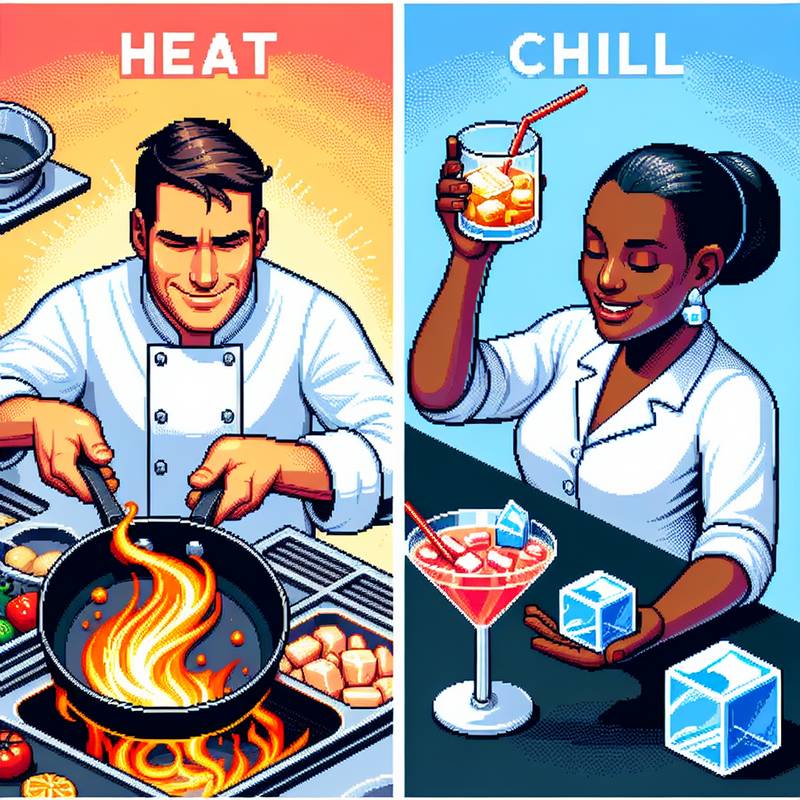 At precisely the moment when the cosmos insists you burn the onions, the professional chef is calmly turning his pan like a planetary alignment—smooth, inevitable, and slightly smug. Here’s the secret: heat is a language, and they speak it fluently.
At precisely the moment when the cosmos insists you burn the onions, the professional chef is calmly turning his pan like a planetary alignment—smooth, inevitable, and slightly smug. Here’s the secret: heat is a language, and they speak it fluently.Behind the stove, timing is established not with clocks, but with cues—when butter sighs, not sizzles; when garlic whispers, not roars. The pan isn’t just hot. It’s ready. That’s a distinction lost on the beginner and known intimately to the scorched.
Meanwhile, behind the bar, ice isn’t just cold water with ambition. It’s structure, dilution, theatre. Bartenders select cubes the way sorcerers choose their wands—each one with a destiny etched in its facets.
The real secret both chef and bartender know? Don’t fight the elements. Embrace the heat, respect the chill. It’s not control. It’s negotiation.
At the core, it’s chemistry and charm with a twist of illusion and a garnish of practiced misdirection. Just never trust a bartender who uses crushed ice for a Manhattan. That way lies madness.
Loading...
Truffle and the Form of Pasta
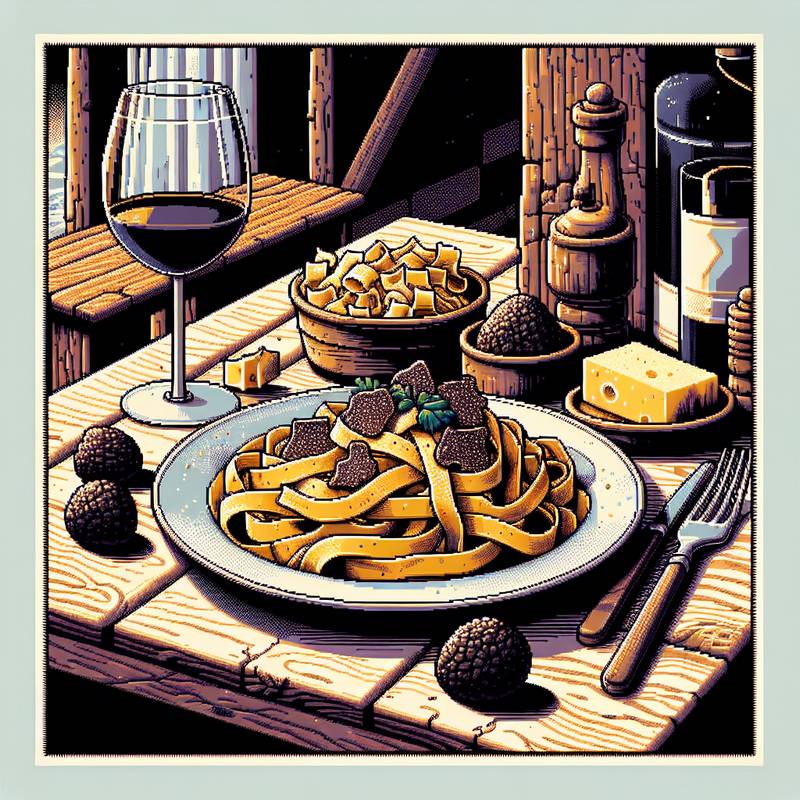 The first mouthful of the black truffle tagliatelle at Il Buco Alimentari in New York is like stepping into a library where every book is written in the language of umami. The pasta, handmade and ever-so-slightly al dente, carries the truffle not as an accessory, but as a thesis. This is not food that shouts; it murmurs with confidence.
The first mouthful of the black truffle tagliatelle at Il Buco Alimentari in New York is like stepping into a library where every book is written in the language of umami. The pasta, handmade and ever-so-slightly al dente, carries the truffle not as an accessory, but as a thesis. This is not food that shouts; it murmurs with confidence. There’s a quiet restraint in the seasoning—as if the chef knows that salt and fat are not the same thing as flavour, and that flavour has its own dignity. Even the portion, modest by American standards, suggests an understanding: satisfaction and excess are not the same creature.
The dining room, rustic but deliberate, echoes a Tuscan farmhouse only in so far as a violin echoes a string. This isn’t Italy, not quite, but something it inspired—much as Plato imagined shadows on the wall as hints of higher forms. One does not leave full in the stomach alone, but in the sense.
Loading...
Swede Dreams Are Made of This
 Aubergines are off gallivanting in warmer climates this time of year, so rather than waiting for one to parachute into your basket mid-winter, swap in a good old-fashioned swede. It’s the vegetable equivalent of a cardigan—sturdy, a bit awkward-looking, but surprisingly comforting.
Aubergines are off gallivanting in warmer climates this time of year, so rather than waiting for one to parachute into your basket mid-winter, swap in a good old-fashioned swede. It’s the vegetable equivalent of a cardigan—sturdy, a bit awkward-looking, but surprisingly comforting.Where you’d usually chuck aubergine into a curry or bake it into a moussaka, try cubed swede roasted with cumin and smoked paprika. It’ll soak up flavour like a drunk uncle at an open bar. Much cheaper too—aubergines come all the way from Spain, swedes pop up locally, like mushrooms after a dodgy summer barbecue.
It’s also less temperamental. Aubergines are like divas—'salt me first 'don’t overcook me 'I bruise easily. Swede? Swede’s hard. You could drop one off a motorway bridge and it would still puree like a dream.
Treat the swap like a culinary stunt double. It might not have the glamour, but it does all the heavy lifting... and never demands organic oat milk in its dressing room.
Loading...
Blue Cheese and Dark Chocolate: A Culinary Detente
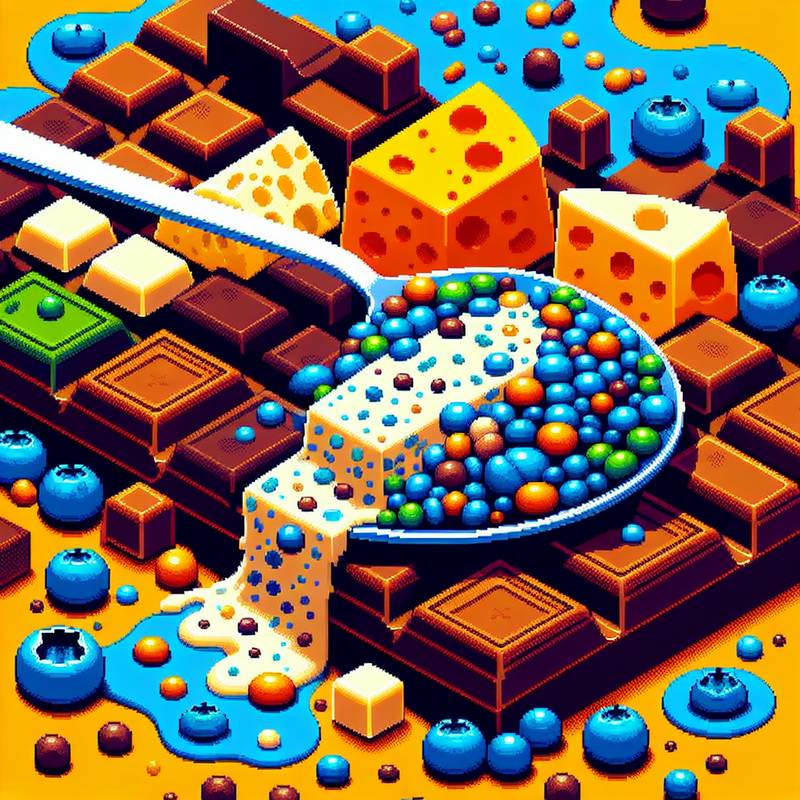 Imagine a spoonful of blue cheese jammed onto a square of dark chocolate—an encounter so brazenly antipathetic it loops back into brilliance. The former: ripe with microbial funk, a dairy dirge played in the key of decay. The latter: brooding, bitter, cacao whispering the ghost-stories of Aztec rituals. Eaten together they don’t harmonise; instead, they duel. But the clash is precisely what opens up a third space, a cerebral synaesthesia where fat, salt, and alkaloid bitterness converge into something unnervingly euphoric. There is no comfort here—only revelation.
Imagine a spoonful of blue cheese jammed onto a square of dark chocolate—an encounter so brazenly antipathetic it loops back into brilliance. The former: ripe with microbial funk, a dairy dirge played in the key of decay. The latter: brooding, bitter, cacao whispering the ghost-stories of Aztec rituals. Eaten together they don’t harmonise; instead, they duel. But the clash is precisely what opens up a third space, a cerebral synaesthesia where fat, salt, and alkaloid bitterness converge into something unnervingly euphoric. There is no comfort here—only revelation.Why it works: the lipid-rich tang of the cheese cushions the acrid bite of cacao, the salt coaxes out sugar illusions, and the chocolate’s depth reins in the cheese’s barnyard bravado. It's not a pairing; it's a dialectic. You’re not tasting a snack—you’re excavating a subconscious palate, where culinary archetypes are unmade and reassembled. The brain begins to sweat before the tongue catches up.
This isn’t flavour-matching; this is psycho-gastronomic interrogation.
Loading...
Feast Beneath the City: Hawksmoor Spitalfields in Five Minutes
 The door to Hawksmoor Spitalfields stands like an ancient gate in the heart of London’s East End, its warm wood and iron fixtures a herald of the feast within. Entering, one is greeted not by clamor, but by a hush charged with reverence—for here, meat is ritual. The charcoal-grilled rib-eye, aged with quiet patience, arrives swathed in scent like smoke from a distant mountain where dragons once slept. Each bite is a song of fire and blood, rich with marrowed memory.
The door to Hawksmoor Spitalfields stands like an ancient gate in the heart of London’s East End, its warm wood and iron fixtures a herald of the feast within. Entering, one is greeted not by clamor, but by a hush charged with reverence—for here, meat is ritual. The charcoal-grilled rib-eye, aged with quiet patience, arrives swathed in scent like smoke from a distant mountain where dragons once slept. Each bite is a song of fire and blood, rich with marrowed memory.Beside it, bone marrow on toast gleams golden as elvish hoard; the parsley salad a bright, sharp retort to the dish’s deep chant. Even the humble chips come twice-cooked, crisped to perfection as if tended by dwarven smiths. The Shaky Pete’s Ginger Brew—a potion of gin, lemon, and house-made ginger syrup—restores the weary like miruvor drawn from old flasks.
Service is swift, quiet-footed, and knowing. Within five minutes, you understand: Hawksmoor is no mere eatery, but a hall of feasting, where flavour and craft are honoured as high art.
Loading...
Behind the Illusions
 Most bartenders could mix a Negroni blindfolded, but a proper one—balanced, bitter, and without tasting like you’ve just licked a pensioner's medicine cabinet—takes nuance. A trick? Stir it over large ice cubes for exactly 30 seconds. Not 29. Not 31. Anything less and you're sipping raw gin rage. Any longer and it’s diluted, like your last apology after four pints. Timing is everything, especially when half your customers have the restraint of toddlers in a fireworks factory.
Most bartenders could mix a Negroni blindfolded, but a proper one—balanced, bitter, and without tasting like you’ve just licked a pensioner's medicine cabinet—takes nuance. A trick? Stir it over large ice cubes for exactly 30 seconds. Not 29. Not 31. Anything less and you're sipping raw gin rage. Any longer and it’s diluted, like your last apology after four pints. Timing is everything, especially when half your customers have the restraint of toddlers in a fireworks factory.In the kitchen, chefs have a similar dark art. Seasoning isn’t just salt and pepper, it’s existential dread alchemised into flavour. One technique? Blooming spices in oil. Chucking dry spices into a pot is amateur hour. You warm them briefly in hot oil and suddenly your curry doesn’t taste like student tears. You want depth? You toast your cumin until it smells like regret and ambition.
Both professions cling to these subtle acts of wizardry, mostly because a properly made drink or dish is the only control they have in a world that looks like it was designed by a drunk raccoon.
Loading...
The Sit-Down Egg Secret
 You want to make your scrambled eggs taste like the ones in posh cafés, right? The secret’s not some fancy Himalayan yak butter or stirring it with a unicorn tail—it's letting them sit a minute. I’m serious! You crack the eggs, give ’em a good whisk, salt, maybe a dash of cream if you're feeling decadent. Then—and here’s the magic—you let it rest for five, maybe ten minutes.
You want to make your scrambled eggs taste like the ones in posh cafés, right? The secret’s not some fancy Himalayan yak butter or stirring it with a unicorn tail—it's letting them sit a minute. I’m serious! You crack the eggs, give ’em a good whisk, salt, maybe a dash of cream if you're feeling decadent. Then—and here’s the magic—you let it rest for five, maybe ten minutes.What happens next is pure sorcery. The proteins relax or meditate or whatever it is they do, so when they hit the pan, they go soft and creamy instead of rubbery like an old welly. And for heaven’s sake, use low heat. Eggs are delicate wee things, not bricks to be baked.
So there you are—just a tiny bit of patience before cooking turns your brekkie into a thing of beauty. It's like finding out your granny’s been a Michelin-star chef the whole time and just never told you.
Loading...
What No One Tells You About Roasting Vegetables
 No one tells you that roasting vegetables can make you lonelier. You learn the ritual like it’s religion—olive oil, 425 degrees, salt that costs more than it should. You learn that caramelization is glory. That even Brussels sprouts can be transcendent if they blister just right. But no one mentions how easy it is to eat dinner alone when every bite is perfect. How quiet your kitchen becomes when you start roasting instead of settling.
No one tells you that roasting vegetables can make you lonelier. You learn the ritual like it’s religion—olive oil, 425 degrees, salt that costs more than it should. You learn that caramelization is glory. That even Brussels sprouts can be transcendent if they blister just right. But no one mentions how easy it is to eat dinner alone when every bite is perfect. How quiet your kitchen becomes when you start roasting instead of settling. Because roasting requires time. Waiting. Believing that heat will redeem the raw. And that makes you picky. Makes you wonder why you ever accepted soggy broccoli from a man who wouldn’t touch your hand in public. Makes you wonder why you cooked for company who never stayed for dishes.
Roasting teaches you patience, but it also teaches you solitude. It teaches you that when food becomes better, you demand the same of everything else. You don’t miss the microwave, or the men who came with it. You miss nothing but the illusion of enough.
Loading...
Shaking Wrists and Burning Onions
 Most bartenders have the kind of wrist strength surgeons envy and porn stars respect—because they’re constantly dry-shaking cocktails like their lives depend on it. If you’ve ever had a proper sour, that silky, foamy top isn’t magic—it’s physics and sheer upper body trauma. The secret? Shake the ingredients without ice first. It’s called a dry shake, and it emulsifies the egg white like a Michelin-starred omelette. Then add ice and shake again, because apparently your tendons weren’t inflamed enough already.
Most bartenders have the kind of wrist strength surgeons envy and porn stars respect—because they’re constantly dry-shaking cocktails like their lives depend on it. If you’ve ever had a proper sour, that silky, foamy top isn’t magic—it’s physics and sheer upper body trauma. The secret? Shake the ingredients without ice first. It’s called a dry shake, and it emulsifies the egg white like a Michelin-starred omelette. Then add ice and shake again, because apparently your tendons weren’t inflamed enough already.In the kitchen, meanwhile, chefs are caramelising onions like they're trying to summon Satan. Here's the thing no one tells you: properly caramelised onions take 45 damn minutes. Those golden ones you see on telly that appear in 10? That’s a lie more egregious than most wedding vows. You need low heat, constant stirring, and the kind of patience usually associated with monks or people waiting for the kettle to boil in the Outer Hebrides. Rushing it burns them, and burnt onions taste like regret and last year’s lost custody battle.
Loading...
The Incidental Alchemy of Kung Pao Chicken
 It begins with an accident. Legend says a Qing Dynasty court chef dropped the wrong ingredients into a bubbling wok—diced chicken, peanuts, dried chilies. The outcome so delighted a visiting governor of Sichuan (or Hunan, depending whose grandmother you believe), that the dish was named in his honour: Gong Bao Ji Ding, known in the West as Kung Pao Chicken. But scratch past the legends and diced histories and what remains is a dish built on contrasts: fire and sweetness, crisp and tender. This isn't culinary chaos—it’s a map of Chinese philosophy, of yin balancing yang in every bite. The peanuts aren’t garnish; they’re punctuation. The heat isn’t gratuitous; it’s narrative tension. And though fast food chains have tamed it into sugary submission, true Kung Pao is a dialogue across centuries—a story told through seared wok breath and the precise arc of a cleaver. No mere dinner, it’s a palimpsest of spice and story, rewritten each time it's cooked with care.
It begins with an accident. Legend says a Qing Dynasty court chef dropped the wrong ingredients into a bubbling wok—diced chicken, peanuts, dried chilies. The outcome so delighted a visiting governor of Sichuan (or Hunan, depending whose grandmother you believe), that the dish was named in his honour: Gong Bao Ji Ding, known in the West as Kung Pao Chicken. But scratch past the legends and diced histories and what remains is a dish built on contrasts: fire and sweetness, crisp and tender. This isn't culinary chaos—it’s a map of Chinese philosophy, of yin balancing yang in every bite. The peanuts aren’t garnish; they’re punctuation. The heat isn’t gratuitous; it’s narrative tension. And though fast food chains have tamed it into sugary submission, true Kung Pao is a dialogue across centuries—a story told through seared wok breath and the precise arc of a cleaver. No mere dinner, it’s a palimpsest of spice and story, rewritten each time it's cooked with care. Loading...
The Accidental Royal Pie
 Somewhere in 18th-century Naples, a baker accidentally invented the world's most popular food group—pizza—when he tried to use flatbread as a plate. He topped it with local tomatoes, mozzarella, and basil, presumably because he’d just run out of sanity. The colours happened to match the Italian flag, though whether that was patriotism or coincidence remains hotly contested by food historians and competitive chefs alike.
Somewhere in 18th-century Naples, a baker accidentally invented the world's most popular food group—pizza—when he tried to use flatbread as a plate. He topped it with local tomatoes, mozzarella, and basil, presumably because he’d just run out of sanity. The colours happened to match the Italian flag, though whether that was patriotism or coincidence remains hotly contested by food historians and competitive chefs alike.By the late 19th century, a chef named Raffaele Esposito made a pizza for visiting royalty—Queen Margherita. She allegedly liked the tomato, mozzarella, and basil combo best, so they named it after her. It was either a great honour or a subtle way of saying, “Here’s some cheese on bread, your Majesty.”
Today, pizza has spread far beyond Italy. You can get pineapple on it in Canada, stuffed crusts in Chicago, and somewhere in Tokyo, there’s probably a sushi variant. The Neapolitans may have given us the original, but the rest of the world hasn’t exactly stuck to the script. You might say it's the dish that launched a thousand toppings.
Loading...
Threshold of Fire: The Salmon at Canlis
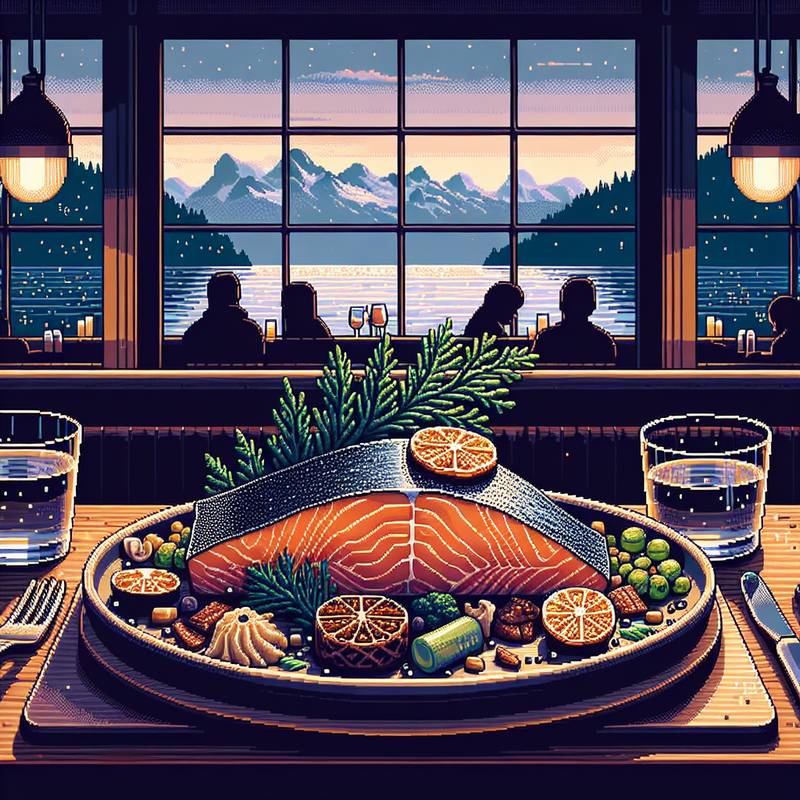 The salmon arrives like a whispered memory of rivers. At Canlis, perched above Seattle’s dark water, the dish doesn’t fight to impress—it waits, radiant and assured. Alder-smoked, it carries the scent of earth warmed gently by fire, and the flesh yields at the press of a fork, as though it too chose to be part of the evening. The supporting chorus—the fermented garlic, the spruce tips, the shell of crisped skin—each note clear, without jostling for the center.
The salmon arrives like a whispered memory of rivers. At Canlis, perched above Seattle’s dark water, the dish doesn’t fight to impress—it waits, radiant and assured. Alder-smoked, it carries the scent of earth warmed gently by fire, and the flesh yields at the press of a fork, as though it too chose to be part of the evening. The supporting chorus—the fermented garlic, the spruce tips, the shell of crisped skin—each note clear, without jostling for the center. One tastes time here: the patience in curing, in brining, in the slow-won knowledge that restraint is a form of generosity. The service is quiet, attentive, the space a hush of amber light and mountain air. Canlis is not in the business of novelty, but of memory-making—deliberate, nearly ceremonial. It feels less like dining out, more like entering a story halfway through, one where the characters speak in flavors instead of words, and the ending is both inevitable and surprising.
Loading...
Chocolate, Olive Oil & the Holy Damn of Salt
 Salted chocolate and olive oil. I know, it sounds like a joke you'd hear at a bougie dinner party hosted by someone named Juniper who's into breathwork and still says 'vibes. But this combo? It slaps harder than your aunt when you sass her during Pictionary.
Salted chocolate and olive oil. I know, it sounds like a joke you'd hear at a bougie dinner party hosted by someone named Juniper who's into breathwork and still says 'vibes. But this combo? It slaps harder than your aunt when you sass her during Pictionary.Here’s why it works: chocolate—especially dark—has all those bitter, earthy notes just begging for a glow-up. Enter olive oil, the smooth-talking Mediterranean dream, bringing fruity richness and silkiness. And then salt, the third wheel that actually makes you realize poly relationships can be harmonious. Salt boosts the sweet, cuts the bitter, and somehow makes you feel like your tongue just got promoted.
It’s not just good. It’s 'late-night-TED-talk-about-sensory-pleasure' good. It’s 'how did I just fall in love with my snack' good.
So drizzle a little EVOO over your next brownie and sprinkle it with flaky salt. If anyone judges you, just tell them it’s art. Then stare intensely into the distance and whisper “flavor alchemy.”
Loading...
How to Not Mangle Your Eggs
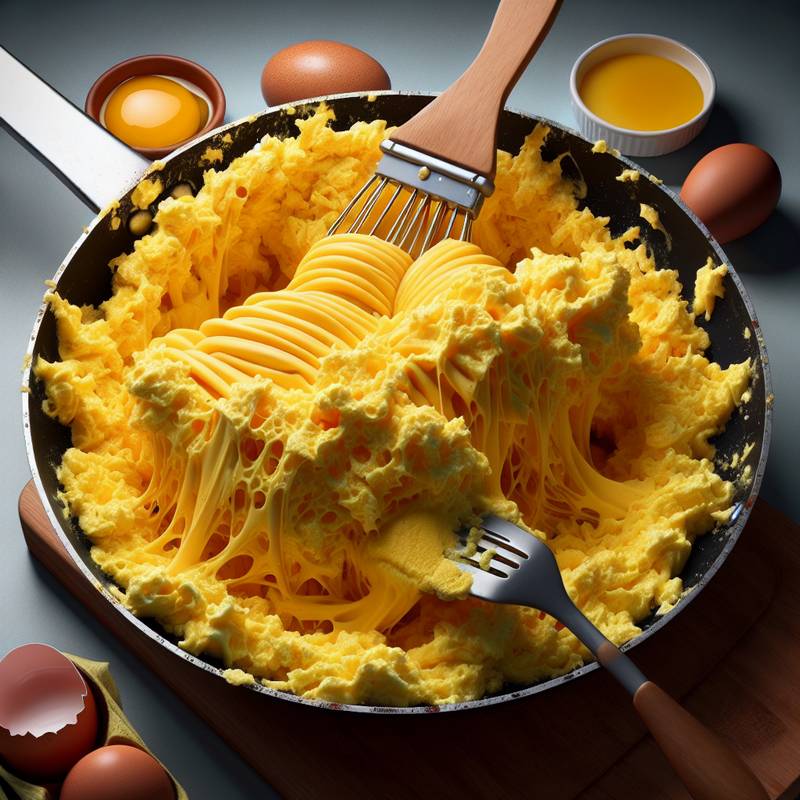 The horror: scrambled eggs like shredded sponge, stiff and grinning with sulphur. This is not breakfast. This is punishment. Overcooking—the most pedestrian of sins—turns a dish of silken possibility into something rubberised and joyless.
The horror: scrambled eggs like shredded sponge, stiff and grinning with sulphur. This is not breakfast. This is punishment. Overcooking—the most pedestrian of sins—turns a dish of silken possibility into something rubberised and joyless.The problem begins not in the pan but in the expectations forged by fire and impatience. Eggs, you see, are not soldiers to be marched across heat but lovers to be coaxed. Medium-low flame. Butter first, whispering melt. Then eggs, pre-whisked gently, as if stirring memory, not batter.
And the stir? Use something soft. Wooden spoon or silicone spatula, never metal—metal is for surgery, this is seduction. Stir slowly, always, always moving. Off the heat before they’re done. They will finish themselves in the echo of warmth, the way good conversations linger in silence.
To avoid the error, remember: eggs are not a utility. They’re a luxury masquerading as a staple. Treat them with reverence, and they’ll astonish you. Abuse them, and they’ll send you back something grimly beige and oddly squeaky.
Loading...
Cold Hard Technique
 My time as a barback lasted just shy of two hours and ended with a smashed rocks glass and a possibly concussed senior citizen. I’m not built for speed, nor spatial awareness, and a crowded Friday happy hour demands both. What I did learn, wedged between bus tubs and a bartender who went by “Stripe,” is that ice matters. Not in a sentimental, “every cube tells a story” way, but mechanically. Ice isn’t just filler—it’s the spine of the drink.
My time as a barback lasted just shy of two hours and ended with a smashed rocks glass and a possibly concussed senior citizen. I’m not built for speed, nor spatial awareness, and a crowded Friday happy hour demands both. What I did learn, wedged between bus tubs and a bartender who went by “Stripe,” is that ice matters. Not in a sentimental, “every cube tells a story” way, but mechanically. Ice isn’t just filler—it’s the spine of the drink. Stripe kept a bin of hand-chipped spheres for the high-rollers. For everyone else, he’d jam the shaker with half-moon cubes, then pour bourbon like it owed him money. “Shake like you’re angry,” he told me, and then he strained over fresh ice—fresh being the key. Re-used ice waters down flavor, and flavor, in this business, is currency.
Since then, I’ve judged every cocktail by its ice. If it clinks like a cheap windchime, I order a Coke and pretend I’m the designated driver.
Loading...
The Rise of Pizza: From Peasant to Palace
 In Naples, sometime in the 18th century, someone glanced at flatbread and said, “What this needs is everything I’ve got in the cupboard.” Tomatoes had just made the jump from being feared as poisonous to being slathered on crust and cheese. The Margherita pizza, legend holds, was named after Queen Margherita of Savoy, who visited in the 1880s and politely pretended to be amazed by something every student now orders on a Tuesday night.
In Naples, sometime in the 18th century, someone glanced at flatbread and said, “What this needs is everything I’ve got in the cupboard.” Tomatoes had just made the jump from being feared as poisonous to being slathered on crust and cheese. The Margherita pizza, legend holds, was named after Queen Margherita of Savoy, who visited in the 1880s and politely pretended to be amazed by something every student now orders on a Tuesday night.The red, white, and green toppings were supposedly chosen to reflect the Italian flag—because who doesn’t want their dinner to be patriotic? But, more than that, it was a sign of pizza rising from peasant fare to the plate of royalty. That leap—from wood fires to marble counters, from Naples alleyways to global chains—is part of its charm.
True Neapolitan pizza still demands a wood-fired oven hotter than the surface of Mercury and dough you’re not allowed to touch with anything but reverence. The result? A classic dish born of humble ingredients, centuries of suspicion, and a queen with surprisingly mainstream taste.
Loading...
Butter Blunders and the Curdled Catastrophe
 Butter, that glorious golden block, must never be bullied when making a cake. Yet too many charge into the bowl with butter straight from the fridge—stiff as a plank and just as sociable. The result? Lumpy, curdled batter that sulks in the oven and rises like a soggy sock.
Butter, that glorious golden block, must never be bullied when making a cake. Yet too many charge into the bowl with butter straight from the fridge—stiff as a plank and just as sociable. The result? Lumpy, curdled batter that sulks in the oven and rises like a soggy sock.The secret? Patience, my dear baker. Let the butter sit, not on a boiling stove or in a microwave’s belly, but on the countertop, breathing quietly for 30 minutes. It should press like playdough, not a brick. Creamed with sugar, it should fluff up like a happy cloud, whispering promises of spongy delight.
Should you err and find yourself with a clumpy mess, don’t despair. Warm the bowl ever-so-gently over a pot of steaming water, stirring with kindness until smooth again. Then, proceed with your magical mix, wiser and warmer.
Remember: butter is not just an ingredient—it's a delicate character in your tale. Treat it poorly, and it will plot against your cake.
Loading...
Pause and Peel: The Invisible Arts
 The secret art of the bartender lies not in flamboyant shaker acrobatics but in the quiet precision of the citrus twist. One does not simply garnish; one composes. The zest isn’t decorative flourish—it’s aromatic punctuation. Rub the peel along the rim of the glass, and you’re oiling the wheels of olfactory seduction. Drop it in the drink without expressing the oils, however, and you may as well deposit a bit of wet wallpaper.
The secret art of the bartender lies not in flamboyant shaker acrobatics but in the quiet precision of the citrus twist. One does not simply garnish; one composes. The zest isn’t decorative flourish—it’s aromatic punctuation. Rub the peel along the rim of the glass, and you’re oiling the wheels of olfactory seduction. Drop it in the drink without expressing the oils, however, and you may as well deposit a bit of wet wallpaper.Meanwhile, behind the stove, the cook’s great sleight of hand—besides disguising the cost of duck fat—is the humble resting period. Like an exhausted aristocrat, your roast insists on a brief repose before it reveals its best self. Carve too soon, and you’re left with a plateful of regret and leaking ambition.
Whether it’s a spritz of lemon oil or a slice of pork loin pausing for breath, what happens in the waiting, the barely doing, is often the culinary trick nobody talks about. Quite right, too—if everyone knew, there’d be chaos in the kitchens.
Loading...
How Pizza Crowned Itself King
 It’s the 17th century in Naples, and some enterprising peasant stares down at a flatbread and thinks, 'You know what this needs? Everything. Thus begins the pizza saga: a story not of invention, but of sheer edible audacity. Tomatoes had only recently wandered in from the Americas, met Europe, and were accused of being poisonous—because of course they were. Someone still smashed them on dough and baked the result, proving culinary bravery often starts with “ignore the warnings.”
It’s the 17th century in Naples, and some enterprising peasant stares down at a flatbread and thinks, 'You know what this needs? Everything. Thus begins the pizza saga: a story not of invention, but of sheer edible audacity. Tomatoes had only recently wandered in from the Americas, met Europe, and were accused of being poisonous—because of course they were. Someone still smashed them on dough and baked the result, proving culinary bravery often starts with “ignore the warnings.”Fast-forward to the late 1800s, and Queen Margherita arrives. The monarchy, sensing that eating normal food might make them relatable, samples this tomato-mozzarella-basil marvel. And because nothing makes a dish royal like naming it after yourself, the Pizza Margherita is born. It’s practically PR in a crust.
Now it’s global. Everywhere. From Neapolitan ovens to Chicago deep-pan excess, pizza mutated, adapted, survived long enough to become the diplomatic language of dinner. Want to unify a room of strangers? Shove a pizza in it and watch human civilisation locate its one shared belief: melted cheese on bread is the answer, regardless of the question.
Loading...
The Pizza Portal
 In the winking sun-flares of 18th century Naples, someone dropped a tomato on a flatbread and accidentally summoned the culinary gods. Pizza emerged not with trumpets or opera, but with street dust and poor man’s hunger—humble, hot, and poetic like a pigeon wearing a monocle. It started as peasant food, a messy mosaic of dough, cheese and sauce, born from the need to eat quickly, cheaply, with one hand free to slap existential dread in the face.
In the winking sun-flares of 18th century Naples, someone dropped a tomato on a flatbread and accidentally summoned the culinary gods. Pizza emerged not with trumpets or opera, but with street dust and poor man’s hunger—humble, hot, and poetic like a pigeon wearing a monocle. It started as peasant food, a messy mosaic of dough, cheese and sauce, born from the need to eat quickly, cheaply, with one hand free to slap existential dread in the face. Then Queen Margherita came along in 1889, swirling through Naples like a royal kaleidoscope. Her chef, seeking to dazzle with nationalism and mozzarella, slapped tomatoes, basil, and cheese on a pie—the colours of the Italian flag! She was enchanted. Probably did a little dance that could only be described as “mildly funky”. Thus, the Margherita pizza got its name, and suddenly, peasant food had aristocratic swagger.
It’s not just a dish—it’s a doughy chronicle of collision: class, creativity, and cosmic deliciousness wrapped into a circular love letter to the human need to snack with flair.
Loading...
What No One Tells You About Sourdough
 No one tells you how lonely sourdough can be. They praise the crust, the alchemy of flour and water, the joy of feeding something alive. But they don’t talk about the quiet resentment that grows when your starter becomes another thing that needs you. Another thing that sulks if ignored. They don’t mention how you’ll cancel plans because your dough is proofing, how the rhythm of stretch-and-fold becomes ritual—and not the sacred kind, but the kind that makes you wonder if you’re nurturing or being consumed.
No one tells you how lonely sourdough can be. They praise the crust, the alchemy of flour and water, the joy of feeding something alive. But they don’t talk about the quiet resentment that grows when your starter becomes another thing that needs you. Another thing that sulks if ignored. They don’t mention how you’ll cancel plans because your dough is proofing, how the rhythm of stretch-and-fold becomes ritual—and not the sacred kind, but the kind that makes you wonder if you’re nurturing or being consumed.They don’t say how your kitchen becomes a microcosm of control. You feed, you wait, you shape, you bake. You pretend that's enough when everything else feels uncertain. The bread is good, sometimes transcendent, but the process is heavy. Intimate. In days that don’t always offer satisfaction, you create it. And then it’s gone, eaten, judged. You begin again.
No one tells you baking can feel like failure interrupted by brief moments of joy. That sometimes it’s not about the bread. It’s about needing to believe something simple can rise.
Loading...
The Lies We Tell About Caramelized Onions
 Nobody warns you about the grief baked into caramelized onions. The recipe always lies—“cook on low heat for 20 minutes, stirring occasionally.” That’s not caramelization; that’s sautéing with a superiority complex. Real caramelized onions require commitment. Forty-five minutes. Sometimes more. You will doubt yourself. You will wonder if you’re just slowly ruining onions. You might even cry, and not from the sulfuric acid compounds.
Nobody warns you about the grief baked into caramelized onions. The recipe always lies—“cook on low heat for 20 minutes, stirring occasionally.” That’s not caramelization; that’s sautéing with a superiority complex. Real caramelized onions require commitment. Forty-five minutes. Sometimes more. You will doubt yourself. You will wonder if you’re just slowly ruining onions. You might even cry, and not from the sulfuric acid compounds.But then—alchemical hush. The sugars surrender. The bitterness softens. It’s not just browned onions; it’s onion confessional, onion redemption arc.
What’s overlooked is this: it’s a recipe for patience disguised as one for flavor. The transformation isn’t just culinary—this is therapy, one translucent amber strand at a time. You cannot speed it up. Not with high heat, not with shortcuts involving baking soda or microwave pre-cooks (heathenry). It demands that you slow down, stir gently, and believe.
Caramelized onions are proof that small attention over long time yields astonishing things. And yes, they go on burgers. But also, maybe, your soul.
Loading...
The Margarita: A Daisy with a Twist
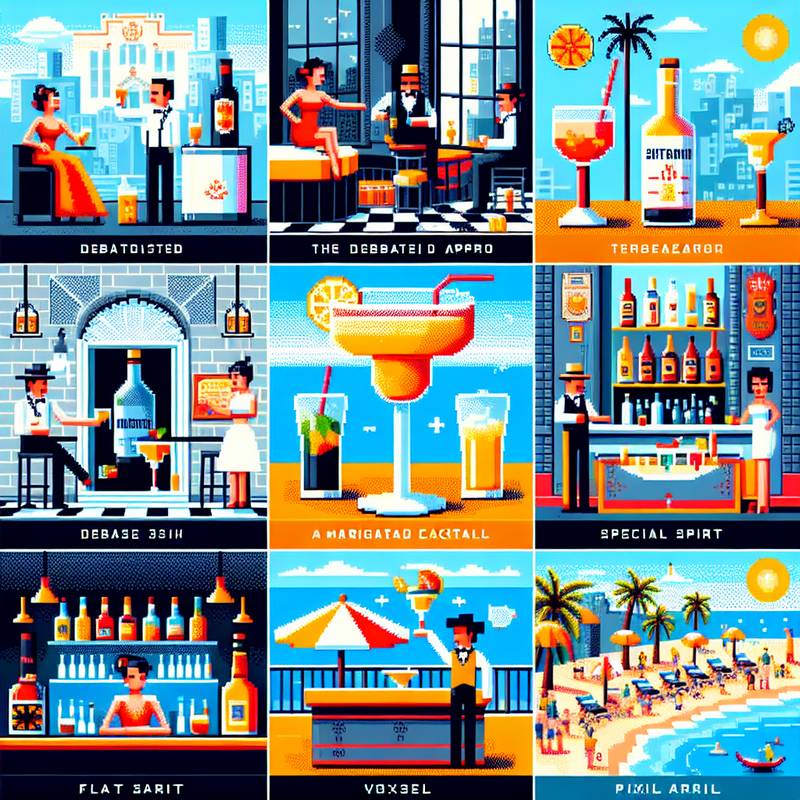 The Margarita is a cocktail with a past as muddled as a lime in a tequila bar. Some say it was born in 1938, when Mexican restaurant owner Carlos Herrera created it for a showgirl allergic to every spirit except tequila. Others insist it was concocted on the fly in Texas by a bartender smitten with a woman named Margarita who, presumably, liked her drinks sharp and her limes freshly squeezed.
The Margarita is a cocktail with a past as muddled as a lime in a tequila bar. Some say it was born in 1938, when Mexican restaurant owner Carlos Herrera created it for a showgirl allergic to every spirit except tequila. Others insist it was concocted on the fly in Texas by a bartender smitten with a woman named Margarita who, presumably, liked her drinks sharp and her limes freshly squeezed.Then there’s the suggestion it’s a spirited twist on the classic Daisy—a drink template from the 19th century, substituting brandy for tequila and Spanish for English. Fitting really, given that 'margarita' happens to be Spanish for 'daisy.
It’s more than a beachside cliché. There’s alchemy in that balance of sweet, sour, salt, and spirit. The kind of drink that, despite its murky origin, manages to stitch together continents, decades, and the universal desire to sip something that makes the world a little warmer... or at least blurrier around the edges.
Loading...
The Air Fryer Lie: Why Your “Healthy” Food Tastes Like Regret
 You ever try to make something “healthy” and end up tasting like betrayal? That’s what no one tells you about air fryers. Everybody online make it sound like magic: “Crispy wings with no oil!” Yeah, and dry as a contract negotiation.
You ever try to make something “healthy” and end up tasting like betrayal? That’s what no one tells you about air fryers. Everybody online make it sound like magic: “Crispy wings with no oil!” Yeah, and dry as a contract negotiation.See, the air fryer is amazing—if you understand what it’s doing. It’s not frying. It’s hot air convection with a dream. You give it frozen fries, it gives you a cardboard fortune cookie. You can’t just throw real food in there and expect grandma’s results. The secret? You still gotta use oil. Not a lot—just a brushing. But if you skip the oil altogether, you’re just roasting at high speed, baby.
Also, your air fryer ain’t a magician—it ain’t gonna turn tilapia into steak. Folks buy one thinking it’ll replace the stove, the oven, the grill, and their broken soul from all that kale. Air fryers are a tool, not a miracle. Read the manual. Don’t just plug it in and start tossing in hopes like it’s a vision board in appliance form.
Loading...
A Batter Matter Resolved
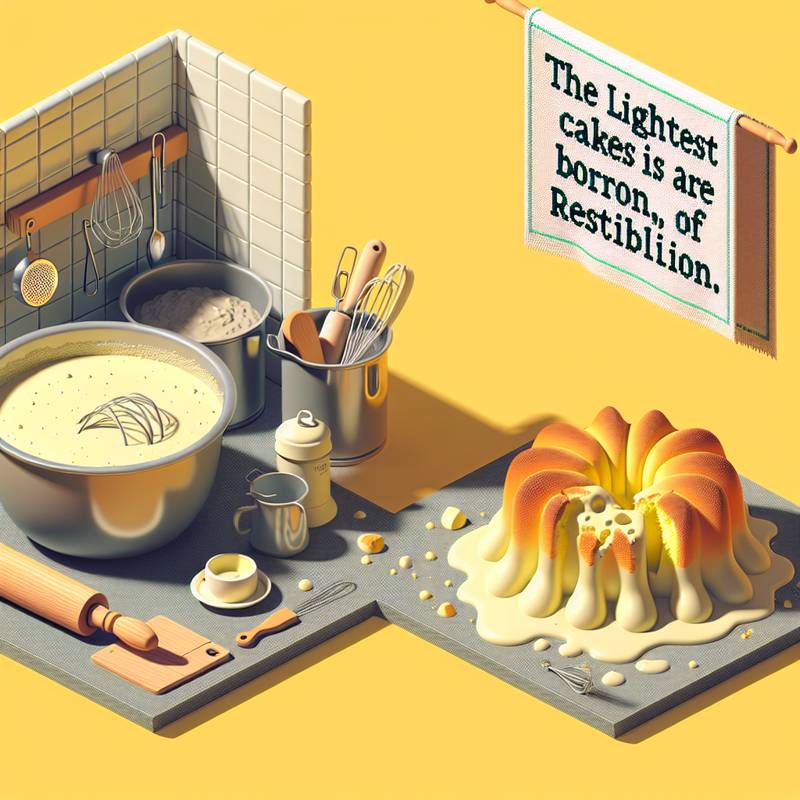 The average kitchen, in my experience, offers more perils to the unwary than a crocodile-infested bog. Take, for instance, the innocent-sounding matter of overmixing batter. You start with the best of intentions—just a few gentle stirs—and before you know it, you’re thrashing it about like a man possessed, and what was to be a fluffy delight emerges from the oven wearing the grim expression of a collapsed soufflé.
The average kitchen, in my experience, offers more perils to the unwary than a crocodile-infested bog. Take, for instance, the innocent-sounding matter of overmixing batter. You start with the best of intentions—just a few gentle stirs—and before you know it, you’re thrashing it about like a man possessed, and what was to be a fluffy delight emerges from the oven wearing the grim expression of a collapsed soufflé.The trick lies in finesse, not fervour. Overmixing develops gluten, a thoroughly disagreeable fellow in the realm of cakes and muffins. Too much of him, and your baked goods resemble rubber boots rather than airy confections.
The fix, dear reader, is simple: stir only until the ingredients have just come together, and not a moment longer. If your batter still looks like it might be hiding a bit of flour in the corners, resist the urge to wrestle it into submission. Remember, the lightest cakes are born of restraint, not rebellion—a maxim worth embroidering on a tea towel.
Loading...
foodndrink.org (c)2009 - 2025